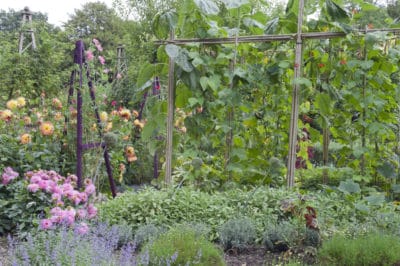How Companion Planting Works
All plants exude chemicals from their stems, leaves, flower and roots. They use these chemicals to communicate with other plants, to repel or attract insects and to fight diseases. For example, scented marigolds are well known to repel root nematodes. Planted the season before, they can clear the plot for following crops. As nitrogen fixers, beans make good companion plants for a wide variety of other vegetables.
Companion Planting Variables
When considering companion planting, you should take the following into account:
- Plant growth habits and size.
- Nutrient needs and soil preferences.
- Watering requirements.
- Insect predators and disease.
- How to attract pollinator insects.
- How to attract predator insects.
- Animals that can become garden pests, such as raccoons or deer.
The Three Sisters
Native Americans are credited with creating one of the classic companion plantings for beans, known as the Three Sisters. These include corn, pole beans and squash. The beans fix nitrogen for the other plants and attract beneficial insects. Corn provides a support for the climbing beans (don’t use bush beans – they’ll be shaded out). The hairy leaves of squash help deter raccoons from ripening corn and shade out weeds in the corn.
Companion Vegetables for Beans
You have many choices when it comes to vegetable companions for beans, although sources may make conflicting recommendations – you should experiment and see what works in your garden. Squash and corn have already been mentioned. Try cucumbers, radishes, eggplants and potatoes, as well as broccoli and cauliflower. Strawberries and tomatoes are other potential companion plants for beans. Carrots and kale are other options.
Herbs and Flowers for Beans
Marigolds – the scented varieties – are well-known companion plants that can suppress root nematodes and deter beetles. Marigolds may also repel deer. Nasturtium is another flower that can repel bean beetles. Catnip repels flea beetles (but may attract the family cat). Summer savory can improve growth and flavor in bean plants.
What Not to Plant with Beans
The so-called plant antagonists may stunt growth, shade out the beans or attract insects. All members of the allium family will inhibit growth in beans. Kohlrabi, basil and fennel don’t seem to make good neighbors. Beans often grow poorly when sunflowers are nearby and peppers may also be a problem. Beets may have a negative effect on pole beans, but not bush beans.
